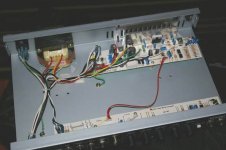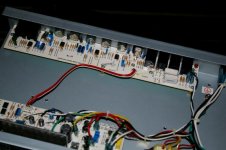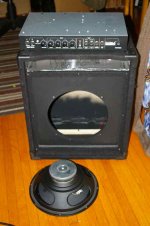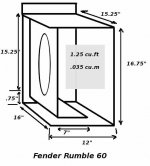I know that the Rumble 25 had some underrated cap problems, which when changed (25v --> 50v) solved distortion/clip/pwr supply problems.
I just inherited this Rumble 60, and I note it seems to have an 8 ohm 100 watt Fender Special musical instrument speaker. Is this the standard guitar-speaker, or is it a different one made for bass? Doesn't sound like a bass-speaker.
The important thing is, can I close off the slot at the bottom of this cabinet for better (flatter) bass response? Max volume isn't as important as the two apparent peaks in the response, one at the low E on a bass-guitar, and one about an octave higher. I'm thinking these peaks are due to the port at the bottom, and I'm wondering if plugging it with 3/4" plywood would improve the sound.
I'm noticing the peaks using a fender precision bass with a simple set of stock pickups.
I just inherited this Rumble 60, and I note it seems to have an 8 ohm 100 watt Fender Special musical instrument speaker. Is this the standard guitar-speaker, or is it a different one made for bass? Doesn't sound like a bass-speaker.
The important thing is, can I close off the slot at the bottom of this cabinet for better (flatter) bass response? Max volume isn't as important as the two apparent peaks in the response, one at the low E on a bass-guitar, and one about an octave higher. I'm thinking these peaks are due to the port at the bottom, and I'm wondering if plugging it with 3/4" plywood would improve the sound.
I'm noticing the peaks using a fender precision bass with a simple set of stock pickups.
Well, I pulled the speaker in the cabinet,
and it looks underpowered. claim 100w but looks more like 50.
It could be distorting. There doesn't seem to be any rubbing,
but I'm not a speaker expert.
The cabinet could use reinforcing,
and it looks like I could reinforce corners/edges inside,
seal the box and port too, and drop in a higher-power smoother speaker.
What should I use for cabinet reinforcement, epoxy?
the speakers on my Twin dwarf the speaker here,
even though its a bass! Looks like Fender cut some corners here.
Has anyone got better bass sound by switching out speaker or cabinet?
Looking at the chassis, the actual amp is a little integrated chip on a heatsink. Doesn't look like much!
I'm wondering if its worth it to just use the chassis to build a 'champ' or Deluxe 60 w tube amp on, and build a separate box for the head!
As they say, the amp is just not loud enough for rock bands,
and the distortion / lack of flatness in the first two octaves is annoying.
What would a circuit for a good 60w tube Bass amp look like?
and it looks underpowered. claim 100w but looks more like 50.
It could be distorting. There doesn't seem to be any rubbing,
but I'm not a speaker expert.
The cabinet could use reinforcing,
and it looks like I could reinforce corners/edges inside,
seal the box and port too, and drop in a higher-power smoother speaker.
What should I use for cabinet reinforcement, epoxy?
the speakers on my Twin dwarf the speaker here,
even though its a bass! Looks like Fender cut some corners here.
Has anyone got better bass sound by switching out speaker or cabinet?
Looking at the chassis, the actual amp is a little integrated chip on a heatsink. Doesn't look like much!
I'm wondering if its worth it to just use the chassis to build a 'champ' or Deluxe 60 w tube amp on, and build a separate box for the head!
As they say, the amp is just not loud enough for rock bands,
and the distortion / lack of flatness in the first two octaves is annoying.
What would a circuit for a good 60w tube Bass amp look like?
The basic speaker looks like this ($45 on Ebay used)

The magnet is quite a lot smaller and lighter than those on the Twin:
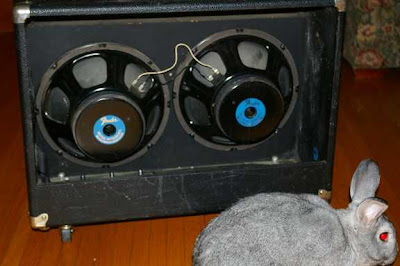
I'm thinking of swapping them!
On the other hand,
The chassis for the Rumble 60 (at least this one) isn't made of Aluminium! It seems to be soft steel.
Its solid, rectangular and just about perfect for a small 2-tube push-pull power section.
I'd have to build a separate wood cabinet for it (Marshall-style).

Somebody already got that idea, and sold a chassis on Ebay.
I'm thinking, now that the Rumble 60 has been discontinued,
and it has gone down from $500 new to about $200 or less used,
it makes a good start-pack for a 'champ' project complete with speaker cabinet!.
I don't know if this speaker would satisfy a guitarist,
but the chassis should satisfy a DIYer!

The magnet is quite a lot smaller and lighter than those on the Twin:

I'm thinking of swapping them!
On the other hand,
The chassis for the Rumble 60 (at least this one) isn't made of Aluminium! It seems to be soft steel.
Its solid, rectangular and just about perfect for a small 2-tube push-pull power section.
I'd have to build a separate wood cabinet for it (Marshall-style).

Somebody already got that idea, and sold a chassis on Ebay.
I'm thinking, now that the Rumble 60 has been discontinued,
and it has gone down from $500 new to about $200 or less used,
it makes a good start-pack for a 'champ' project complete with speaker cabinet!.
I don't know if this speaker would satisfy a guitarist,
but the chassis should satisfy a DIYer!
Okay here's a closer look:
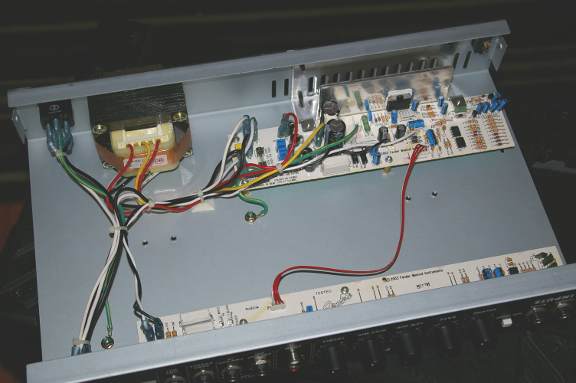
16.5 " wide x 9.75 " deep x 2.75 " (at back. 2.25" front) chassis
Recommendations:
Chuck integrated chip-amp,
and build tube amp on chassis, mount it in separate Marshall-style box.
------------------------------
12" underpowered "Fender Special" speaker, small magnet (prob.50w)
Bass Reflex Cabinet w. slot along bottom:
9" deep X 15 3/8" wide x 15 1/4" high (16 3/4" at back) interior box,
= 2140 cubic inches (1.24 ft³, .035 m³ )
with port/slot = 3/4" high x 16" wide, (12 Sq. In.)
and about 7" deep. (84 cubic in. in volume).

As it is, the cabinet has a horrible "honk/peak" with the low E string,
and another one about an octave higher. Very uneven bass response,
the four-knob EQ doesn't fix this,- not even in the ballpark.
Recommendations:
Put real 200 watt speaker in it,
seal port with plywood block,
add midrange speaker (in separate compartment) and crossover.
Reinforce cabinet walls with crossbraces,
and foam 3 sides inside to stop standing reflections.

16.5 " wide x 9.75 " deep x 2.75 " (at back. 2.25" front) chassis
Recommendations:
Chuck integrated chip-amp,
and build tube amp on chassis, mount it in separate Marshall-style box.
------------------------------
12" underpowered "Fender Special" speaker, small magnet (prob.50w)
Bass Reflex Cabinet w. slot along bottom:
9" deep X 15 3/8" wide x 15 1/4" high (16 3/4" at back) interior box,
= 2140 cubic inches (1.24 ft³, .035 m³ )
with port/slot = 3/4" high x 16" wide, (12 Sq. In.)
and about 7" deep. (84 cubic in. in volume).

As it is, the cabinet has a horrible "honk/peak" with the low E string,
and another one about an octave higher. Very uneven bass response,
the four-knob EQ doesn't fix this,- not even in the ballpark.
Recommendations:
Put real 200 watt speaker in it,
seal port with plywood block,
add midrange speaker (in separate compartment) and crossover.
Reinforce cabinet walls with crossbraces,
and foam 3 sides inside to stop standing reflections.
Attachments
Subscribed.
Interested to see what you do here. I've got a Fender Rumble 100 sitting around (100W amp, 15" speaker) - looking for ideas of what to do with it. That is assuming I don't just sell it (naturally, I already have a half dozen half finished projects)
If I remember correctly, the chassis is quite substantial (or at least enough to hold a couple of transformers without issue. Could be fun to turn it into say a 50W tube amp. For pure laziness, tempting to get a 5F6-A Bassman kit (minus chassis) and put that in there. About to make an order from Mable Audio, and I think I could get the kit minus chassis for around $250. Otherwise, maybe beef it up with a couple of bridged chip amps?
Think I would write off the speaker to be honest, IIRC it's a low end Eminence in the Rumble 100, but it's far from the prettiest sounding speaker.
Interested to see what you do here. I've got a Fender Rumble 100 sitting around (100W amp, 15" speaker) - looking for ideas of what to do with it. That is assuming I don't just sell it (naturally, I already have a half dozen half finished projects)
If I remember correctly, the chassis is quite substantial (or at least enough to hold a couple of transformers without issue. Could be fun to turn it into say a 50W tube amp. For pure laziness, tempting to get a 5F6-A Bassman kit (minus chassis) and put that in there. About to make an order from Mable Audio, and I think I could get the kit minus chassis for around $250. Otherwise, maybe beef it up with a couple of bridged chip amps?
Think I would write off the speaker to be honest, IIRC it's a low end Eminence in the Rumble 100, but it's far from the prettiest sounding speaker.
Subscribed.
Interested to see what you do here. I've got a Fender Rumble 100 sitting around (100W amp, 15" speaker) - looking for ideas of what to do with it. That is assuming I don't just sell it (naturally, I already have a half dozen half finished projects)
If I remember correctly, the chassis is quite substantial (or at least enough to hold a couple of transformers without issue. Could be fun to turn it into say a 50W tube amp. For pure laziness, tempting to get a 5F6-A Bassman kit (minus chassis) and put that in there. About to make an order from Mable Audio, and I think I could get the kit minus chassis for around $250.
This sounds like a great idea!
The chassis seem to be steel, which is why this may be a great choice.
If Fender had put some quality in the cabinet rather than the chassis,
it would have had a winning amp. As it is, maybe its a winning DIY project!
Otherwise, maybe beef it up with a couple of bridged chip amps?
I can't see how putting any chip amps can improve it at all.
Its already got chip amps (unless the 100 has a couple of discrete transistors instead).
After talking to my speaker expert guy,
I'm convinced that 90% of the (bad) sound from these units,
is coming from the cheaply made speaker enclosure.
I'm going to reinforce mine, and block at least part of the port.
If I can flatten out the honky peaks in the lower range (30-160 Hz),
Then it will sound far better at every volume above 3.
I may not even need to replace the speaker,
as stiffening and sealing the cabinet will allow it to handle more power without distorting excursions.
I agree the speakers are cheap in these things.Think I would write off the speaker to be honest, IIRC it's a low end Eminence in the Rumble 100, but it's far from the prettiest sounding speaker.
But I can't help feeling the cabinet is contributing
the greater part of the horribly unflat response.
I'd rather lose a little volume and get a flat fretboard,
because I might even eliminate the need for compression,
while preserving playing dynamics when I actually want them.
If I were you, I'd pull out your 15" and take a look in there.
I'll bet you'll see cheap.
And you can tap on each side of the enclosure with it empty:
I think you'll see that every side plays a different annoying note, like a cheap African drum.
I'm thinking of putting 1" x 1" strips across each side, on a diagonal,
and screwing/gluing them in place to deaden each side.
Then I'm going to put a layer of thick and weighty mattress stuffing on three opposing sides to stop reflections and standing waves.
I may also block up corners inside with triangular blocks.
I am betting the cabinet will sould 400% better with the same speaker.
I will keep you posted.
The speakers are definitely underpowered, but this is my first strike at the problem.
Maybe it will be better if not okay.
Then I will assess the need for replacing the speaker.
Tough call, cause almost any good woofer with ridged edges (relfex type) would improve the power-handling.
Last edited:
This sounds like a great idea!
The chassis seem to be steel, which is why this may be a great choice.
If Fender had put some quality in the cabinet rather than the chassis,
it would have had a winning amp. As it is, maybe its a winning DIY project!
Yeah I'm weighing off the gains from just selling vs. modding... hmm, oh the choices...
It does occur to me that I currently have a 1970's era 100w tube head to refurbish, a 410 I'm going to rebuild into 2x 210's, etc etc, but this could be an interesting diversion.
If I went for turning it into a tube head, I'd probably remove the chassis and make a new head for it (not enough space for the transformers and tubes) but it's 19" wide and that's wider than I'd like for it. Then figure out what to do with that 15. Perhaps make an ultralight 112 cube?
The question is, where is the point of diminishing returns? That is, how many mods to plan before just selling it and putting it toward new gear instead of simply modding a poorly designed unit?
If I were you, I'd pull out your 15" and take a look in there.
I'll bet you'll see cheap.
And you can tap on each side of the enclosure with it empty:
I think you'll see that every side plays a different annoying note, like a cheap African drum.
I'm thinking of putting 1" x 1" strips across each side, on a diagonal,
and screwing/gluing them in place to deaden each side.
Then I'm going to put a layer of thick and weighty mattress stuffing on three opposing sides to stop reflections and standing waves.
I may also block up corners inside with triangular blocks.
I am betting the cabinet will sould 400% better with the same speaker.
I remember I took the speaker out a few years back and it did look rather woeful inside. They seem to have cheaped out a bit too hard on this.
Admittadly, I haven't played through it in quite a while (it's currently lying down with a couple of amps and whatnot on top) so I can't quite remember the sound - BUT I'd be willing to take a stab and say you're right - add bracing, some stuffing (don't think mine has any either) and perhaps seal it off and you might be on a winner. Obviously, just flat out sealing without changing the volume can go either way, but without specs on that speaker, only one way to find out. Once you get into the territory of replacing the speaker
EDIT: also, out of interest, how wide is the chassis itself on yours? Looks to be around 14" (~350mm)
Last edited:
EDIT: also, out of interest, how wide is the chassis itself on yours? Looks to be around 14" (~350mm)
Ok the chassis is 16.5" wide (without any sides),
and 10" deep (ignoring transformer bulge and knobs).
I'm guessing a separate 'head' box will be:
(inside: 16.75" x 12" deep (allow for knobs/fuses) x 8" (3" + at least 5"))
Add 3/4" ply (x2) box:
18.25" x 12 (or 13)" deep by 10" high.
You can use the metal speaker-grill (cut) as a front/back grid above the chassis / knobs, to keep fingers out of front and back, and have plywood top, bottom and sides.
Carpet (or woodfinish) and corners as desired.
Makes for a sweet looking 60w push-pull head.
To update:
I've added wheels (a necessity with any amp larger than a 10watt).
Also:
I reinforced the inside with a cross-piece horizontal pine board about 1" thick and 4" wide, edgewise toward speaker-back, cutting back-panel in half. Screws in sides and back and glue to hold.
I added a 16" piece of 2x4 in bottom, after removing fruity lightshow panel, right on bottom and right against port-hole inside blocking it: glued and screwed from bottom/sides (1.5" screws).
Long-screws were used on ends (from side).
I used a spray-can of insulating-foam, filling port, corners and edges all around inside box. Worked well.
I replaced speaker and tested:
The two main resonances were still there, (49 Hz and 98 Hz), but a little less bad. Much of the cabinent distortion on other notes however were cleaned up, so this cabinet reinforcement is really worth doing.
I went back to my buddy at the speaker store, asked about a notch-filter. This was not good news, as the cap/inductor combo would require 150 mH (HUGE if aircore) and 20,000 - 40,000 uF caps. The cost was ridiculous, and the coil was made of unobtainium.
But the good news is speaker expert recommended stuffing the cabinet full of quilt-stuffing material to kill all standing waves.
So I gutted a 'comforter/pillow' and stuffed cabinet and replaced speaker:
FANTASTIC!
The two main resonances were about 80% killed off (still a slight and noticable peak/resonance but the bass guitar was actually playable and the notes near the 'resonance' weren't all blended together and indistinguishable.
Also, the whole bass fretboard was not only playable but sounded musically awesome (especially two-note stuff and octaves)!
Bass Guitar amp went from pure honky crap to sonic bliss.
Pull all your bass woofers, reinforce sides and stuff the box full!
You will be amazed.
Now the amp actually doesn't sound so bad (for a transistor),
although the EQ is still crap.
In an ordinary room (practice, coffeeshops) it seems more than adequate.
Also seems to work good as a small guitar amp (maybe better than as a bass).
Still, speaker seems underpower for useful playing.
I'm now thinking of just adding a tube-circuit (12ax7 etc.) inside the box for an 'overdrive' channel:
You don't have to make a separate 'head' for this.
I will get back again on this.
I've added wheels (a necessity with any amp larger than a 10watt).
Also:
I reinforced the inside with a cross-piece horizontal pine board about 1" thick and 4" wide, edgewise toward speaker-back, cutting back-panel in half. Screws in sides and back and glue to hold.
I added a 16" piece of 2x4 in bottom, after removing fruity lightshow panel, right on bottom and right against port-hole inside blocking it: glued and screwed from bottom/sides (1.5" screws).
Long-screws were used on ends (from side).
I used a spray-can of insulating-foam, filling port, corners and edges all around inside box. Worked well.
I replaced speaker and tested:
The two main resonances were still there, (49 Hz and 98 Hz), but a little less bad. Much of the cabinent distortion on other notes however were cleaned up, so this cabinet reinforcement is really worth doing.
I went back to my buddy at the speaker store, asked about a notch-filter. This was not good news, as the cap/inductor combo would require 150 mH (HUGE if aircore) and 20,000 - 40,000 uF caps. The cost was ridiculous, and the coil was made of unobtainium.
But the good news is speaker expert recommended stuffing the cabinet full of quilt-stuffing material to kill all standing waves.
So I gutted a 'comforter/pillow' and stuffed cabinet and replaced speaker:
FANTASTIC!
The two main resonances were about 80% killed off (still a slight and noticable peak/resonance but the bass guitar was actually playable and the notes near the 'resonance' weren't all blended together and indistinguishable.
Also, the whole bass fretboard was not only playable but sounded musically awesome (especially two-note stuff and octaves)!
Bass Guitar amp went from pure honky crap to sonic bliss.
Pull all your bass woofers, reinforce sides and stuff the box full!
You will be amazed.
Now the amp actually doesn't sound so bad (for a transistor),
although the EQ is still crap.
In an ordinary room (practice, coffeeshops) it seems more than adequate.
Also seems to work good as a small guitar amp (maybe better than as a bass).
Still, speaker seems underpower for useful playing.
I'm now thinking of just adding a tube-circuit (12ax7 etc.) inside the box for an 'overdrive' channel:
You don't have to make a separate 'head' for this.
I will get back again on this.
Last edited:
Hi nazaroo, could you please share with more pictures?
I'm building copy of Rumble 60 and desperately looking for any material.....
From the ones you uploaded, I see that fender didn't use crossbraces? Is that very important?
Yes, I'd say thats VERY important!
I found that playing the Rumble 60 was awful,
as in not playable usefully past a very low volume.
This is because on at least two spots on the bass fretboard,
the notes for a 3 or 4 fret span were all blurred together and way too loud.
This was because of built-in resonances,
and made the little 12" speaker/cabinet useless.
I added heavy bracing, and stuffed the cabinet FULL of
blanket/comforter stuffing to stop the resonances,
and make the amp/speaker playable.
I also sealed up the reflex-slot and removed the light-show,
to make the cabinet have a more flat response over the whole fretboard.
This was the only thing that saved the amp/speaker combo.
Note that some volume was lost with those mods,
but this was necessary to restore musicality and balance.
One could additionally add a Karlson-type interface,
increasing the size of the cabinet,
but also doubling the volume for a given watts or loudness setting.
12" underpowered "Fender Special" speaker, small magnet (prob.50w)
Bass Reflex Cabinet w. slot along bottom:
9" deep X 15 3/8" wide x 15 1/4" high (16 3/4" at back) interior box,
= 2140 cubic inches (1.24 ft³, .035 m³ )
with port/slot = 3/4" high x 16" wide, (12 Sq. In.)
and about 7" deep. (84 cubic in. in volume).

As it is, the cabinet has a horrible "honk/peak" with the low E string,
and another one about an octave higher. Very uneven bass response,
the four-knob EQ doesn't fix this,- not even in the ballpark.
Recommendations:
Put real 200 watt speaker in it,
seal port with plywood block,
add midrange speaker (in separate compartment) and crossover.
Reinforce cabinet walls with crossbraces,
and foam 3 sides inside to stop standing reflections.
Thanks for your response nazaroo!
you mean, you sealed that .75" gap on the bottom of front?
isn't that needed to let the pressure out, so speaker won't blow up?
I also sealed up the reflex-slot and removed the light-show,
you mean, you sealed that .75" gap on the bottom of front?
isn't that needed to let the pressure out, so speaker won't blow up?
Thanks for your response nazaroo!
you mean, you sealed that .75" gap on the bottom of front?
isn't that needed to let the pressure out, so speaker won't blow up?
Yes I blocked that, to get a smoother frequency response.
No, unless you are pumping ridiculous levels of power into it.
The sealed cabinet should limit the excursion somewhat,
protecting the speaker against physical overload.
I think there is some problems with paper-accordion surrounds (i.e., guitar speakers) handling extreme excursions of bass,
and supposedly the surrounds can tear.
It may be that this speaker (the original equipment) is susceptable to this, if pushed:
It certainly looks rather underrated (small magnet etc.) for a bass speaker.
But I think Fender would have put a speaker in that can handle bass,
since they contract speaker-makers to customize their speaker requirements.
I haven't overdriven it, but no one should with a small cab/speaker like this. Its strictly for practice and coffee-shops.
I was tempted to drop in a guitar-speaker (higher power) but resisted the temptation, since guitar-speakers are not made for bass-excursion.
I am still tempted to further modify the cab:
That is, put a Karlson-skirt on it to greatly amplify the loudness for a given wattage. If this was done properly,
the amp/speaker combo could probably power a rock-band / bar scene.
I've heard that paper ones are the better (more "natural") sounding speakers generally.
I guess I will have to experiment on sound practically...
Sure, bass guitar may tear guitar speaker, but it also depends on what power you push into it. But also, speaker can't produce the frequencies that is not in its range, right? So scientifically speaking if speaker range is 80-5000hz, then let's say 5 string bass's low string B can not be heard at all there, speaker will just not produce it, although it may be wasted in thermal energy in coil, but I don't think it'll tear it.
I guess I will have to experiment on sound practically...
I was tempted to drop in a guitar-speaker (higher power) but resisted the temptation, since guitar-speakers are not made for bass-excursion.
Sure, bass guitar may tear guitar speaker, but it also depends on what power you push into it. But also, speaker can't produce the frequencies that is not in its range, right? So scientifically speaking if speaker range is 80-5000hz, then let's say 5 string bass's low string B can not be heard at all there, speaker will just not produce it, although it may be wasted in thermal energy in coil, but I don't think it'll tear it.
Oh, I just forgot, how thick are the walls for box of Rumble 60?
I chose 0.7 inch (18mm) thick for sides, top and bottom.
And I want to find (still looking for) 0.5 inch (12mm) for front.
is that okay?
You don't want to skimp on the frontplate.
It will be flexing, and if the speaker is significantly smaller, then the whole front-plate will warble.
If anything, I'd use at least 3/4" ply, and even reinforce it
by running a strip or support from each corner to the speaker-edge. Especially with a bass cab, where real motion is involved.
You don't want to skimp on the frontplate.
It will be flexing, and if the speaker is significantly smaller, then the whole front-plate will warble.
If anything, I'd use at least 3/4" ply, and even reinforce it
by running a strip or support from each corner to the speaker-edge. Especially with a bass cab, where real motion is involved.
Hm... Weird. Speaker is not so heavy - 5.3lbs (2.4kg)
I've been suggested to get thinner, as long as, if the speaker has some sort of unbalanced frequency responses, thin wood would sort of balance it, in a way that it would eat up some frequencies (of course we're not talking about some certain measures - just experiment)....
I'll go for thick, like you suggest. But why exactly ply and not MDF? Because of weight?
MDF is pretty heavy.
Hm... Weird. Speaker is not so heavy - 5.3lbs (2.4kg)
I've been suggested to get thinner, as long as, if the speaker has some sort of unbalanced frequency responses, thin wood would sort of balance it, in a way that it would eat up some frequencies (of course we're not talking about some certain measures - just experiment)....
I'll go for thick, like you suggest. But why exactly ply and not MDF? Because of weight?
MDF is pretty heavy.
I guess you could use MDF, but it may be more prone to crumbling, and its heavier. Also, MDF dulls sawblades real fast. Hardly worth it.
Its supposed benefits over plywood appear marginal.
I guess you could use MDF, but it may be more prone to crumbling, and its heavier. Also, MDF dulls sawblades real fast. Hardly worth it.
Its supposed benefits over plywood appear marginal.
As it's only a fraction of the cost, I wouldn't say that was marginal?.
Personally I've always used chipboard, which is even cheaper - and many (if not most?) professional speakers used to do the same.
Only real problem with chipboard and MDF is the weight, otherwise it's fine - and acoustically 'deader' than plywood.
Well, two qualifiers:As it's only a fraction of the cost, I wouldn't say that was marginal?.
(1) I get plywood free usually, in the garbage,
or bins at nearby construction sites.
Canada is a rich country in regard to wood.
(2) If you're a manufacturer this becomes more significant.
But if you are building a single pair of speakers,
who cares, if its a one-time cost, and
when plywood is only $20-$60 a 4' x 8' sheet?
If your speakers are going to sit in your living room for years at a time, I guess weight really isn't a big deal.Personally I've always used chipboard, which is even cheaper - and many (if not most?) professional speakers used to do the same.
Only real problem with chipboard and MDF is the weight, otherwise it's fine - and acoustically 'deader' than plywood.
But if you're lugging the speaker cabinet to and from gigs,
in cars or up stairs, then it probably becomes significant.
- Status
- This old topic is closed. If you want to reopen this topic, contact a moderator using the "Report Post" button.
- Home
- Live Sound
- Instruments and Amps
- Fender Rumble 60 - what mods to clean this up?
